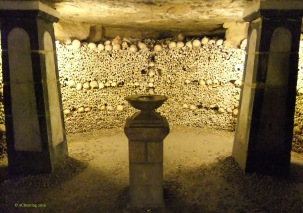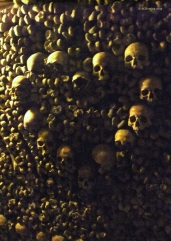During a recent sabbatical from the institution, Ludwig and I engineered a minor diversion and absconded, our vagrant feet taking us quite by chance to nearby St Pancras station. With our bellies full of mischief, we stowed aboard a train bound for Paris, and were abroad in that city for four whole days before the gendarmes caught up with our whereabouts and returned us, iron-clad, to Doctor Jack’s sanctuary. Though our sojourn was to be desperately brief, I determined to make hay while the sun shone – joie de vivre, as they say – and as I‘d heard other inmates describe the strange and macabre beauty of the Paris catacombs (amongst other tawdry tales), I convinced Ludwig that we should try to squeeze in a quick visit during our adventures.
 Thus, on a warm, spring afternoon we found ourselves amidst a growing horde of visitors, slouched in a serpentine queue that coiled restlessly around Place Denfert-Rochereau in the district of Montparnasse. A second-hand guidebook kept us occupied meanwhile, as I related to my companion how it was that the catacombs came to be. Apparently, in the 18th century, Paris’ cemeteries had been full to bursting, with the resulting leakage causing something of a stink. In 1785 the authorities decided to disinter the remains of these bloated boneyards, transporting them for storage in disused quarry tunnels lying below the city’s streets [1]. The first graves to be exhumed were at the Cimetière des Innocents in 1786, and the remains of over six million Parisians were subsequently transferred from graveyards between the late 18th and mid-19th centuries [2].
Thus, on a warm, spring afternoon we found ourselves amidst a growing horde of visitors, slouched in a serpentine queue that coiled restlessly around Place Denfert-Rochereau in the district of Montparnasse. A second-hand guidebook kept us occupied meanwhile, as I related to my companion how it was that the catacombs came to be. Apparently, in the 18th century, Paris’ cemeteries had been full to bursting, with the resulting leakage causing something of a stink. In 1785 the authorities decided to disinter the remains of these bloated boneyards, transporting them for storage in disused quarry tunnels lying below the city’s streets [1]. The first graves to be exhumed were at the Cimetière des Innocents in 1786, and the remains of over six million Parisians were subsequently transferred from graveyards between the late 18th and mid-19th centuries [2].
The line shuffled excruciatingly slowly towards the museum’s entrance. Once through the turn-stile, we descended narrow, stone steps which led to a series of rooms lined with display boards detailing the geological evolution of the Paris basin and the history of the limestone quarrying which created this network of tunnels. Winding through the dimly-lit passageways, the subterranean air was noticeably cool and still, and as we ventured further, echoes of nervous chatter glanced off the walls like the chirruping of playful bats.
 At last we reached the entrance to the ossuary, over which a stone lintel bore the legend, ‘Arrête! C’est ici l’empire de la mort’ (‘Halt! This is the realm of the dead’). We crossed the threshold and were greeted by the most staggering array of human bones, neatly stacked to either side of a roughly-hewn passage which disappeared into the gloom. Immediately one noticed how beautifully the bones had been organised; radial bones layered separately from tibias and femurs, creating an undulating, knobbly lattice-work studded with skulls. In places, the skulls were arranged together in simple designs, like stones set in wet sand at the beach. Hearts and crosses seemed to be popular motifs, recalling the folk art of Central America or pre-Christian Europe.
At last we reached the entrance to the ossuary, over which a stone lintel bore the legend, ‘Arrête! C’est ici l’empire de la mort’ (‘Halt! This is the realm of the dead’). We crossed the threshold and were greeted by the most staggering array of human bones, neatly stacked to either side of a roughly-hewn passage which disappeared into the gloom. Immediately one noticed how beautifully the bones had been organised; radial bones layered separately from tibias and femurs, creating an undulating, knobbly lattice-work studded with skulls. In places, the skulls were arranged together in simple designs, like stones set in wet sand at the beach. Hearts and crosses seemed to be popular motifs, recalling the folk art of Central America or pre-Christian Europe.
 As we traced our route through the tunnels, reading the plaques that indicated the cemeteries from which the remains had come, I pondered the many stories that these old bones might tell. On top of one stack lay a broken skull, its mandible gone, the back of the cranium smashed away. At some forgotten time, that hollow cavity would have been filled with aspirations and anxieties, treasured memories and primal impulses. Perhaps some brilliant scientific genius had thrived in there, or a celebrated artisan. I noted cracked and punctured skulls and, again, wondered whether the owners had met bad ends in dark Parisian alleys, or simply fallen under the gravedigger’s mattock. With millions laid to rest down here, it seemed as if all life must be present.
As we traced our route through the tunnels, reading the plaques that indicated the cemeteries from which the remains had come, I pondered the many stories that these old bones might tell. On top of one stack lay a broken skull, its mandible gone, the back of the cranium smashed away. At some forgotten time, that hollow cavity would have been filled with aspirations and anxieties, treasured memories and primal impulses. Perhaps some brilliant scientific genius had thrived in there, or a celebrated artisan. I noted cracked and punctured skulls and, again, wondered whether the owners had met bad ends in dark Parisian alleys, or simply fallen under the gravedigger’s mattock. With millions laid to rest down here, it seemed as if all life must be present.
 Eventually, the exhibit trailed off as the path meandered back up to street level. Returning to the sunlight, young Ludwig remarked that the catacombs had not been as spooky or as grisly as he’d imagined, but that they were instead rather sad. I shared his melancholy mood, but I’d also been half expecting a lurid, Grand Guignol with crude theatrics, so was grateful that the museum was laid out simply and thoughtfully, and that its occupants were not marketed for cheap thrills. Instead, our hosts humbly invited us to pause and consider our own fragile mortality, and in return our imaginations breathed life into those old bones. Ordinarily, we might have only abstract notions about the lives of strangers, of what goes on behind the façades of the city’s streets. Meeting so many strangers here, after all their songs had been sung, I considered that, inevitably, each phrase ends with the same refrain; its tempo set by an indifferent sweep of the scythe.
Eventually, the exhibit trailed off as the path meandered back up to street level. Returning to the sunlight, young Ludwig remarked that the catacombs had not been as spooky or as grisly as he’d imagined, but that they were instead rather sad. I shared his melancholy mood, but I’d also been half expecting a lurid, Grand Guignol with crude theatrics, so was grateful that the museum was laid out simply and thoughtfully, and that its occupants were not marketed for cheap thrills. Instead, our hosts humbly invited us to pause and consider our own fragile mortality, and in return our imaginations breathed life into those old bones. Ordinarily, we might have only abstract notions about the lives of strangers, of what goes on behind the façades of the city’s streets. Meeting so many strangers here, after all their songs had been sung, I considered that, inevitably, each phrase ends with the same refrain; its tempo set by an indifferent sweep of the scythe.
[1] Le Nevez, C., Pitts, C. & Williams, N. (2015); Paris [10th edition], Lonely Planet Publications Pty Ltd, London
[2] http://www.catacombes.paris.fr/en/catacombs/more-2000-years-history
© RMRenfield and Blackwood Article, 2015

